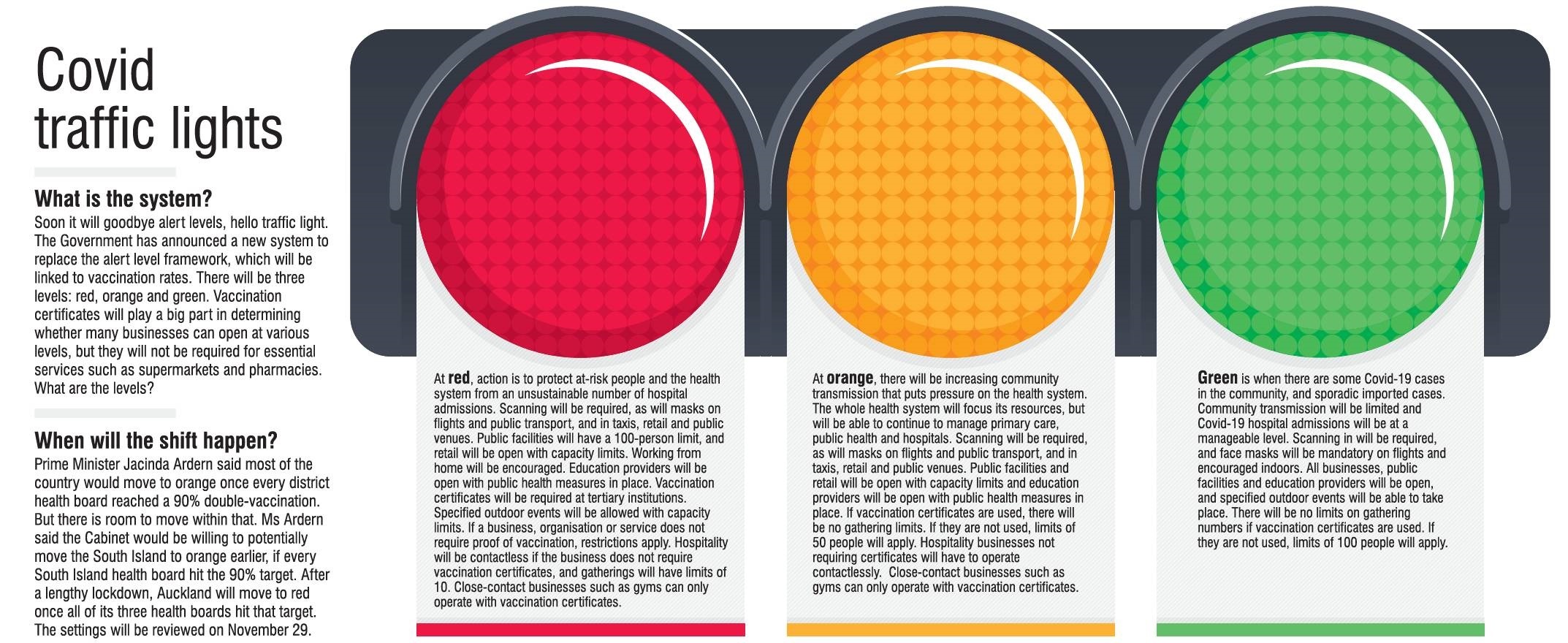A new Covid-19 level system that could lead to restrictions easing in the South Island before the rest of the country has drawn cautious optimism.
Prime Minister Jacinda Ardern yesterday announced the new traffic-light system to replace the current alert level system, which is likely to spell the end of national lockdowns.
It features red, orange, and green settings based on Covid spread and pressure on the health system.
The new system will begin once district health boards have 90% of their eligible populations fully vaccinated.
Ms Ardern also signalled Cabinet would be willing to move the South Island into the orange level early, once all its health board areas hit that target.
Businesses will be able to operate at each level with varying levels of restrictions, and vaccination certificates will become a major part of accessing hospitality businesses, retail, events, and public facilities.
The new system was welcomed by many in the business community, but there was still concern about a lack of clarity around timeframes for restrictions being eased.

Yesterday the Ministry of Health announced 129 new Covid-19 community cases.

Southern DHB Covid-19 vaccine programme lead Hamish Brown said the goal was to vaccinate at least 90% of the eligible population by Christmas.
With fewer than 11,000 people to go before hitting that goal, it was making good progress, he said.
As of yesterday, 87.4% of the eligible population had at least one dose, and 72.4% were fully vaccinated.
‘‘The more people who are vaccinated, the better our communities are protected so we hope to get this number as high as possible.’’
A new $120 million government fund has also been established to help lift Maori vaccination rates.
In the Southern district, 71.3% of Maori have had at least one dose and 53.2% are fully vaccinated.
‘‘We welcome all support to reach our vulnerable Maori communities and will look at what the additional funding might mean for our efforts in Southern,’’ Mr Brown said.

He believed there was also a moral obligation to make sure the 90% vaccination rate was evenly spread across communities, whether that be by age, neighbourhood or ethnicity.
The target needed to be ‘‘a floor and not a ceiling’’.
‘‘It’s the absolute minimum we need, not just in terms of hitting the targets that have been set by the Government today, but making sure we limit the public health risk.’’

‘‘There will be those who don’t want to protect themselves, and their world will shrink around them,’’ he said.
He was hopeful the South could reach the 90% target. He and Gore Mayor Tracy Hicks would be taking their caravans and DHB vaccinators around more remote parts of Southland to help people get vaccinated.
He believed any move to get people travelling and out and about in their communities would be welcomed by businesses as well.

But he was concerned about how realistic it was to expect every health board to reach the 90% target.
‘‘I just don’t think we’re going to get there,’’ he said.
‘‘There could be one small pocket that doesn’t and we’re stuck with what we’ve got.’’
Philip Wheble, West Coast DHB senior officer responsible for the Covid-19 response, said he expected Coast GPs and pharmacies would be able to vaccinate people from early in the new year.
Both DHB and Poutini Waiora staff had been phoning people who had not engaged in the programme to invite them to get vaccinated.
‘‘We are working with our health system partners to reduce as many barriers as possible to enable the remaining 6000 eligible West Coasters to get vaccinated.’’
Mr Wheble said Coast vaccination rates were proportionately lower among youth (aged 12-19) and younger adults (19-24). He believed that was partly because the rollout initially focused on older people.
There were 2,902,031 people fully vaccinated as of yesterday, 69% of the eligible population.
- Additional reporting Greymouth Star












